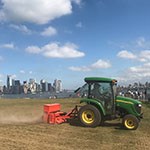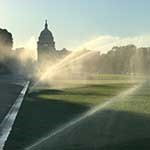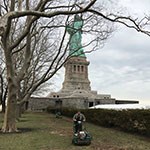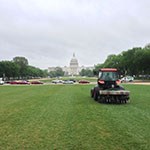

Left image
The renovated National Mall Turf in front of the US Capitol Building.
Credit: NPS
Right image
The National Mall Turf before the renovation project.
Credit: NPS
Taking Care of Turf
National Park Service take care of some of our nation's most precious turf. This requires both day-to-day maintenance of turf resources as well as major projects. Some projects -such as the restoration of the National Mall turf shown above - are intense rehabilitation, recovery, or preservation projects that are highly complex, high dollar, and even garner the attention of the nation.Over the course of decades of management of turf resources day-in and day-out and thorough complexities, the NPS has led the way in crerating turf management best practices that can help you better tackle your turf management goals.
The Basics of Turf Management

Mowing
Mowing is the most important management tool in maintaining turf. Whether it is a formal lawn that gets mowed twice a week or a battlefield that gets moved twice a year. Mowing frequently can determine quality and density, moving height can prevent or encourage weeds along with drought tolerance. Blade sharpness can prevent disease.
Irrigation
Irrigation is the second most important management tool for turf grass. There are many types of technology available to deliver water to the plan to meet different site challenges. Too much water can rob the plant of much needed oxygen, while too little water can cause the turf to go dormant. Management of water is very important to a consistent attractive lawn.
Soils
Grasses can live in all types of soils. From sand to clay, there is a turf type that is best for specific soils. But there never seems to be the perfect soil. So aerification, topdressing, fertility, and water management are all important to a healthy grass stand.Seed
Choosing the right seedBlending
Fertilizer
Reading a LabelChoosing a fertilizer

Sustainable Turf Management
Choosing the right grass varieties and develop a fertilizer program are two keys to sustainable turf management.NPS Turf Classes
NPS has defined turf classes to guide parks in setting objectives for turf management and maintenance. Each turf class and sub classes have specifications for the desired condition to assist managers in aligning management objectives with maintenance needs. The class and maintenance practices should fit the park management objectives.Turf varies greatly across the park system by function, asset value, species mix, and maintenance requirements. Turf may be valued as a facility asset, a natural resource, a cultural resource, or a combination of these, depending upon the situation. As a facility, turf may function as a durable ground surface for a picnic area or a ball field. As a natural resource, turf may be composed of native grass species that shelters wildlife. As a cultural resource, turf may be a historic feature of a cultural landscape that represents an earlier period of time. Each National Park Service unit makes a selection of management choices based on these criteria.
The NPS turf is categorized into “Basic” and “Specialty” classes.
Basic Turf Classes
B1 Functional/Short Turf
Functional short turf is composed of industry-standard species. This sub class of basic turf requires a medium level of effort to achieve, and may be widely distributed throughout developed areas and visitor use areas in parks. As the typical purpose of functional short turf is to provide a generally green ground cover for passive recreational activities, a higher proportion of turf-compatible weeds are considered appropriate.
B2 Functional/Tall Turf
Speciality Turf Classes
S1 Lawn Turf
Lawns are composed of cool and/or warm season grasses that tolerate a low mowing height. This sub class is one of two specialty turfs requiring the highest level of effort in maintenance to achieve (along with S2 sports turf). Lawns should be limited to discrete areas that have management objectives requiring the highest turf quality, that may include monuments, memorials, and some designed landscapes. The typical purposes of lawns are commemoration and passive recreation.
S2 Sports Turf
This is a smooth, resilient ground cover of grasses with cushion, that is mostly free of weeds.
Sports turf is composed of cool and/or warm season grasses that tolerate a low mowing height and are grown on a cushioned substrate. This sub class is one of two specialty turfs requiring the highest level of effort in maintenance to achieve (along with S1 lawn turf). Sports turf should be limited to discrete areas with management objectives for active recreation, such as athletic sports fields. The typical purpose of sports turf is to provide a durable, safe surface for sports activities.
S3 Period Turf
This represents turf in a historic period and is variable in appearance, depending upon the period. Period turf depicting eras prior to the Agricultural Revolution (prior to World War II) is somewhat uniform to irregular ground cover of grasses. Period turf depicting the modern era of turf management after 1945 may be more uniform, similar to B1 functional/short turf or S1 lawn turf.
Period turf is generally composed of traditional grass species, rather than industry-standard species. This sub class of specialty turf is variable in the level of maintenance effort to achieve. As a general rule, the older the historic period represented by turf, the lower the maintenance requirements. Period turf compatible weeds may be appropriate. Period turf should be limited to areas within cultural landscapes that have management objectives to depict a period of significance. The typical purpose of period turf is to evoke the historic character of a cultural landscape.
S4 Managed Tall Cover
Managed tall cover can be composed of native and/or non-native compatible vegetation, depending upon the park’s management objectives. This sub class of specialty turf requires a low to medium level of effort to achieve, and may be widely distributed throughout non-visitor use areas in parks. As the typical purpose of managed tall cover is to provide a herbaceous plant community (to depict a historic pasture or field, for example) or a grass ecosystem, woody plants are excluded. Managed tall cover is visually, rather than physically, accessed. A high proportion of non-native, but compatible weeds may be considered appropriate.
Last updated: January 24, 2023
